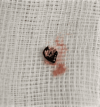Post-traumatic Brodie's Abscess of the Tarsal Cuboid: A Case Report and Review of the Literature
- PMID: 38420079
- PMCID: PMC10901192
- DOI: 10.7759/cureus.53158
Post-traumatic Brodie's Abscess of the Tarsal Cuboid: A Case Report and Review of the Literature
Abstract
Brodie's abscess of the tarsal cuboid is a relatively rare presentation of this disease. In this study, we present the case of a 20-year-old male with post-traumatic Brodie's abscess of the tarsal cuboid that was left untreated for three years after the traumatic episode (penetrating injury with a sharp piece of wood). The patient presented pain over the injured area, limping, while plain foot radiographs showed a small lytic cavitary area in the cuboid. The magnetic resonance imaging revealed the presence of the abscess in a 2-cm diameter cavity in the cuboid bone and chronic inflammation of the surrounding plantar musculature. The treatment regime included curettage of the cavity, debridement of the inflammatory tissues, and administration of antibiotics, according to the cultures harvested intraoperatively, for six weeks. During this period, symptoms completely resolved.
Keywords: brodie's abscess; chronic sub-acute osteomyelitis; curettage; escherichia coli; infection; penetrating trauma; tarsal cuboid.
Copyright © 2024, Tzellios et al.
Conflict of interest statement
The authors have declared that no competing interests exist.
Figures






References
-
- Brodie's abscess of the cuboid in a pediatric male. Agarwal S, Akhtar MN, Bareh J. J Foot Ankle Surg. 2012;51:258–261. - PubMed
Publication types
LinkOut - more resources
Full Text Sources
